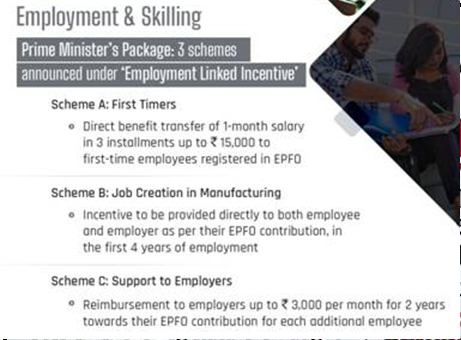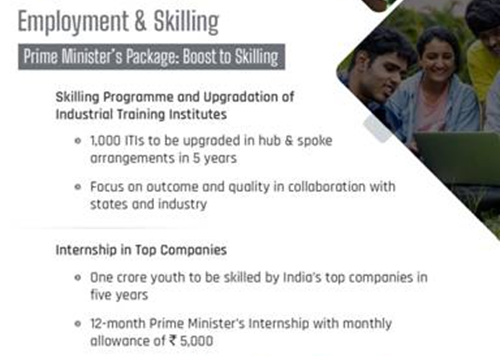BUDGET 2024: FOR THE SOCIAL SECTOR, IT IS OLD WINE IN AN OLD BOTTLE
Relevance:
GS 2 –
- Government policies and interventions for development in various sectors and issues arising out of their design and implementation.
- Issues relating to development and management of Social Sector/Services relating to Health, Education, Human Resources.
GS 3 – Government Budgeting
Why in the news?
- Allocations for numerous social sector schemes have decreased in real terms in the budget 2024.
- This is despite identifying youth, farmers, women, and the poor as the main focus groups.
Economic Survey and Social Sector Allocations
- The Economic Survey includes a chapter titled ‘Social Sector: Benefits that Empower’
- The chapter highlights India’s high and sustained economic growth, accompanied by social and institutional progress
- It credits this progress to transformational and effective implementation of government programmes with an empowering edge
- Despite this, the approach appears to involve decreasing budget allocations in real terms for numerous social sector schemes
| New Welfare Approach in the Economic Survey
Focus:
Growth and Spending:
Inequality:
Ayushman Bharat Scheme:
Early Childhood Education: ‘Poshan Bhi Padhai Bhi’ programme aims to create the world’s largest high-quality preschool network at Anganwadi Centres Educational Initiatives:
|
Disappointing Lower Allocations in Budget 2024
- Education:
- School education allocation increased by ₹5,000 crore
- Higher education allocation increased by ₹3,000 crore
- Higher estimated ‘recoveries’ indicating increased fees and self-financing schemes
- Health and Family Welfare:
- Allocation barely increased by ₹1,500 crore compared to last year
- MGNREGA:
- Allocation remains the same as the revised estimates (RE) for last year
- Sends a message to states about available funds, affecting the availability of work on the ground
- Food Subsidy:
- Minimal increase, despite the need to expand coverage and address rising economic costs of food grains
- PDS still using 2011 Census population figures
- Samarthya:
- Allocation reduced to ₹2,517 crore (from ₹2,582 crore)
- PMMVY excludes at least half the eligible women, amount of ₹5,000 per pregnant woman unchanged since 2017
- National Social Assistance Programme (NSAP):
- Budget remains unchanged at ₹9,652 crore
- Reduction in real terms, no room for increased coverage or adjustment for inflation
- Central contribution to social security pensions remains ₹200 per person per month since 2009.
- Smaller, Critical Schemes:
- POSHAN scheme (school mid-day meal) allocation increased slightly from ₹11,600 crore to ₹12,467 crore
- Less than actual expenditure in 2022-23 (₹12,681 crore)
- Saksham Anganwadi scheme allocation increased to ₹21,200 crore (from ₹20,554 crore)
- No hope for higher salaries for Anganwadi workers (unchanged since 2018) or higher honorariums for mid-day meal cooks
- POSHAN scheme (school mid-day meal) allocation increased slightly from ₹11,600 crore to ₹12,467 crore
Government Justification of Reductions
- Reductions not justified by better schemes taking their place
- Government Focus Shifted:
- Towards contributory schemes (e.g., Atal Pension Yojana for pensions)
- Increased privatisation and commercialisation in education and health
- Emphasis on ‘cost-effectiveness’ in social spending
- Described by the Economic Survey as a “pillar of the new approach to welfare”
- Issues with the New Approach:
- Inadequate consideration of problems with applying market principles to social services
- Neglects long-term economic returns from improving human development outcomes
- Ignores equity considerations in various social sectors.
The Employment Challenge
- Private Sector Expectations:
- High expectations from the private sector to address the employment challenge
- Includes schemes under the ‘Prime Minister’s Package for Employment and Skilling’:
- Government-sponsored internships
- Formalisation of jobs through incentives for EPFO enrolments
- Skill-development programmes
- Budgetary Allocations:
- Entire package allocated ₹2 lakh crore over five years
- Much of the funding is linked to the industry’s response
- Private sector required to use CSR funds towards this package, effectively subsidising wages for themselves
- Concerns:
- CSR funds meant for societal contributions are redirected to subsidise private sector wages
- No discussion on addressing dampened demand, stagnant wages, or reviving employment
- Focus is solely on supply-side schemes to incentivise private sector employment
- Previous similar attempts have failed, uncertain if this package will succeed.
Way Forward
- Reevaluation of Priorities: Ensure allocations match the actual requirements of sectors like education, health, and welfare
- Enhanced Efficiency: Focus on improving the efficiency of existing schemes and programs to maximize impact per rupee spent
- Implement performance-based budgeting to ensure funds are used effectively
- Strengthen Public-Private Partnerships: Explore partnerships with the private sector and NGOs to complement government efforts and leverage additional resources
- Focus on Equity: Ensure that allocations and policy measures are equitable and address the needs of marginalized and vulnerable populations
- Incorporate equity considerations in budgetary decisions and planning
- Review and Reform Policies: Regularly review and reform policies and schemes to address inefficiencies and adapt to changing needs
- Consider revising schemes that are not yielding expected outcomes or are outdated
- Engage Stakeholders: Engage with stakeholders, including community organizations, experts, and beneficiaries, to gather feedback and refine approaches
- Foster collaboration and dialogue to ensure that budgetary decisions are informed and responsive to on-ground realities
- Expand Coverage: Increase coverage and benefits of critical social schemes to meet growing demands and rising costs
- Adjust allocations in line with inflation and population growth to maintain effective support levels.
Alternative Articles:
https://universalinstitutions.com/a-disservice-to-the-education-sector/
https://universalinstitutions.com/health-regulations-need-a-base-to-top-approach/
Mains question
Discuss the implications of decreased allocations in the Budget 2024 for key social sector schemes. How can the government address these challenges to ensure effective social welfare outcomes? (250 words)





